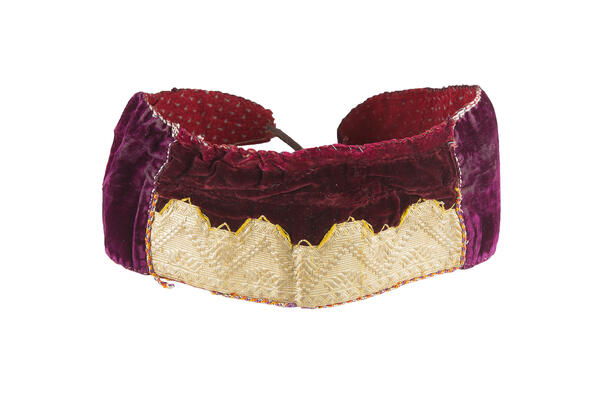The pozatylnik presented in the museum is an element of women’s headdress.
The item belonged to the Semeiskie — a community of Old Believers from Poland, who were forced to relocate to Transbaikalia in the 18th century.
Traditionally, girls of all ages had to cover their hair at home, on the street, and in church. The women’s headdress of the Semeiskie included several elements: a shawl, a kichka, a pozatylnik, and a kokoshnik. Craftswomen sewed and decorated headdresses at home.
The kichka was a head cap which covered the hair. It was made of cotton cloth with a high firm brim which fit tightly on the forehead.
In the Bichursky, Mukhorshibirsky, and Tarbagataysky districts of the Transbaikal area, the kichka was made in the form of a small hoof. Its front was decorated with a sash — a strip of fabric with a beaded pattern. Sometimes drake feathers, previously dipped into boiling oil in order to give them a curved shape, were added to the decorations.
A Semeiskie woman had several shawls in her wardrobe. Thick items made of wool yarn were worn in winter; fine colored cashmere wool and cotton were used for items worn in warmer weather. The Transbaikal Old Believers had a special kind of shawl called atlas. It was a large two-by-two-meter fabric made of thin silk threads. It was tied on the head like a turban gathered in the front, on the forehead. Researchers believe that the Semeiskie people brought satin from Europe.
Most often, on ordinary days, the Semeiskie women wore only the shawl and kichka, as other pieces were worn only on holidays. The pozatylnik was a solid base made of cardboard or birch bark covered with fabric: velvet, brocade, or silk. It was decorated with webbing, lace, gold threads, or beads on the top. Young women used to tie the pozatylnik in the back to the kichka.
The kokoshnik was the last element of the headdress. It was worn on top of the kichka and pozatylnik. In some Transbaikal districts, for example, in the village of Bichura, Semeiskie young women did not wear kokoshniks, as their festive dress was complimented only by the pozatylnik.
Notwithstanding that the Semeiskie and their descendants still live in Transbaikalia, their traditional headdress have fallen out of use since the beginning of the 20th century, thus, they do not make it anymore. Presently, its elements can be seen only in museums.
The item belonged to the Semeiskie — a community of Old Believers from Poland, who were forced to relocate to Transbaikalia in the 18th century.
Traditionally, girls of all ages had to cover their hair at home, on the street, and in church. The women’s headdress of the Semeiskie included several elements: a shawl, a kichka, a pozatylnik, and a kokoshnik. Craftswomen sewed and decorated headdresses at home.
The kichka was a head cap which covered the hair. It was made of cotton cloth with a high firm brim which fit tightly on the forehead.
In the Bichursky, Mukhorshibirsky, and Tarbagataysky districts of the Transbaikal area, the kichka was made in the form of a small hoof. Its front was decorated with a sash — a strip of fabric with a beaded pattern. Sometimes drake feathers, previously dipped into boiling oil in order to give them a curved shape, were added to the decorations.
A Semeiskie woman had several shawls in her wardrobe. Thick items made of wool yarn were worn in winter; fine colored cashmere wool and cotton were used for items worn in warmer weather. The Transbaikal Old Believers had a special kind of shawl called atlas. It was a large two-by-two-meter fabric made of thin silk threads. It was tied on the head like a turban gathered in the front, on the forehead. Researchers believe that the Semeiskie people brought satin from Europe.
Most often, on ordinary days, the Semeiskie women wore only the shawl and kichka, as other pieces were worn only on holidays. The pozatylnik was a solid base made of cardboard or birch bark covered with fabric: velvet, brocade, or silk. It was decorated with webbing, lace, gold threads, or beads on the top. Young women used to tie the pozatylnik in the back to the kichka.
The kokoshnik was the last element of the headdress. It was worn on top of the kichka and pozatylnik. In some Transbaikal districts, for example, in the village of Bichura, Semeiskie young women did not wear kokoshniks, as their festive dress was complimented only by the pozatylnik.
Notwithstanding that the Semeiskie and their descendants still live in Transbaikalia, their traditional headdress have fallen out of use since the beginning of the 20th century, thus, they do not make it anymore. Presently, its elements can be seen only in museums.



